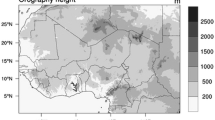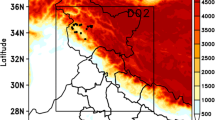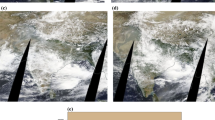Abstract
Accurate forecast of rainstorms associated with the mei-yu front has been an important issue for the Chinese economy and society. In July 1998 a heavy rainstorm hit the Yangzi River valley and received widespread attention from the public because it caused catastrophic damage in China. Several numerical studies have shown that many forecast models, including Pennsylvania State University National Center for Atmospheric Research’s fifth-generation mesoscale model (MM5), failed to simulate the heavy precipitation over the Yangzi River valley. This study demonstrates that with the optimal initial conditions from the dimension-reduced projection four-dimensional variational data assimilation (DRP-4DVar) system, MM5 can successfully reproduce these observed rainfall amounts and can capture many important mesoscale features, including the southwestward shear line and the low-level jet stream. The study also indicates that the failure of previous forecasts can be mainly attributed to the lack of mesoscale details in the initial conditions of the models.
Similar content being viewed by others
References
Bei, N. F., and S. X. Zhao, 2002: Mesoscale analysis of severe local heavy rainfall during the second stage of the 1998 meiyu season. Chinese J. Atmos. Sci., 26(4), 526–540. (in Chinese)
Chen, G. T.-J., C.-C. Wang, and D. T.-W. Lin, 2005: Characteristics of low-level jets over Northern Taiwan in mei-yu season and their relationship to heavy rain events. Mon. Wea. Rev., 133, 20–43.
Chen, Y.-L., X. A. Chen, S. Chen, and Y.-H. Kuo, 1997: A numerical study of the low-level jet during TAMEX IOP 5. Mon. Wea. Rev., 125, 2583–2604.
Cheng, L.-S., and W.-H. Feng, 2001: Analyses and numerical simulation on an abrupt heavy rainfall and structure of a mesoscale vortex during July 1998. Chinese J. Atmos. Sci., 25(4), 465–478. (in Chinese)
Dudhia, J., 1993: A nonhydrostatic version of the Penn State-NCAR mesoscale model: Validation tests and simulation of an Atlantic cyclone and cold front. Mon. Wea. Rev., 121, 1493–1513.
Falkovich, A., E. Kalnay, S. Lord, and M. M. Mathur, 2000: A new method of observed rainfall assimilation in forecast model. J. Appl. Meteor., 39, 1282–1298.
Grell, G. A., J. Dudhia, and D. R. Stauffer, 1994: A description of the fifth-generation Penn State/NCAR Mesoscale Model (MM5). Tech Note NCAR/TN-3981STR, Boulder, CO., 122pp.
Hu, B.-W., C.-G. Cui, and C.-H. Fang, 2001: Cause of successively extremely heavy rain along the Changjiang Valley in the Eastern Hubei Province during 21–22 July 1998. J. Atmos. Sci. Chinese, 25(4), 479–491. (in Chinese)
Liu, S.-Y., Y.-G. Zheng, H.-Q. Wu, and Q.-L. Wu, 2002: Analyses of heavy rain in Huaihe river basin during 28 June–2 July 1998. Acta Meteor. Sinica, 60(6), 774–779.
Meng, Z.-Y., X.-D. Xu, and L.-S. Chen, 2002: TBB-nudging four-dimensional data assimilation method and simulations on heavy rain process in Wuhan on 20 July 1998. Chinese J. Atmos. Sci., 26(5), 663–676. (in Chinese)
Nagata, M., and Y. Ogura, 1991: A modeling case study of interaction between heavy precipitation and a low-level jet over Japan in the baiu season. Mon. Wea. Rev., 119, 1309–1336.
Ninomiya, K., and T. Akiyama, 1974: Band structure of meso-scale echo cluster associated with low-level jet stream. J. Meteor. Soc. Japan, 52, 300–313.
Pereira Fo, A. J., K. C. Crawford, and D. J. Stensrud, 1999: Mesoscale precipitation fields. Part II: Hydrometeorologic modeling. J. Appl. Meteor., 38, 102–125.
Sun, J., and P. Zhao, 2003: Simulation and analysis of three heavy rainfall processes in 1998 with WRF and MM5. Acta Meteorologica Sinica, 61(6), 692–701. (in Chinese)
Shi, J., T.-L. Shen, and P.-X. Wang, 2009: Study on genetic algorithm assimilation of GPS precipitable water data and its application. Acta Meteorologica Sinica, 29(5), 584–590.
Tsuboki, K., 2007: High-resolution simulations of highimpact weather systems using the cloud-resolving model on the earth simulator. High Resolution Numerical Modelling of the Atmosphere and Ocean, K. Hamilton, and W. Ohfuchi, Eds., Springer, 141–156.
Wang, B., J.-J. Liu, S. Wang, W. Cheng, J. Liu, C. Liu, Q. Xiao, and Y.-H. Kuo, 2010: An economical approach to four-dimensional variational data assimilation. Adv. Atmos. Sci., 27, 715–727, doi: 10.1007/s00376-009-9122-3.
Wang, J.-J., and S.-Y. Tao, 2002: Structure and formation of mei-yu front in 1998. Journal of Applied Meteorological Science, 13(5), 526–534. (in Chinese)
Xu, X.-D., Y.-H. Weng, Z.-Y. Meng, and M.-Y. Zhou, 2002: Characteristics of the convection in the mesoscale front of the serious storm rainfall over the Wuhan-Huangshi region during July of 1998 through variational analysis by satellite data. Chinese J. Atmos. Sci., 26(6), 663–676. (in Chinese)
Yuan, Z.-H., 2005: Variational assimilation of GPS precipitable water into MM5 mesoscale model. Acta Meteorologica Sinica, 63(4), 391–404. (in Chinese)
Zhang, X., B. Wang, Z.-Z. Ji, and W.-T. Lin, 2002: Three-dimensional variational data assimilation implemented in numerical modeling for “98.7” Wuhan torrential rain. Progress in Natural Sciences, 12(6), 445–448.
Zhang, M., Y.-Q. Ni, and F.-Q. Zhang, 2007: Variational assimilation of GPS precipitable water vapor and hourly rainfall observations for a meso-β scale heavy precipitation event during the 2002 meiyu season. Adv. Atmos. Sci., 24(3), 509–526, doi: 10.1007/s00376-007-0509-8.
Zhao, S.-X., J.-H. Sun, H. Chen, and F. Zhang, 1998: Study of heavy rainfall in the Changjiang River during July 1998. Climatic and Environmental Research, 3(4), 368–381. (in Chinese)
Zhou, X., S. Zhao, and B. Zhang, 1984: A numerical simulation of the meso-low formation on mei-yu front. Chinese J. Atmos. Sci., 8(4), 353–361. (in Chinese)
Zhou, Y. S., G. Deng, T. Lei, and J. H. Ju, 2005: The thermodynamic and dynamical features of double front structures during 21–31 July 1998 in China. Adv. Atmos. Sci., 22(6), 924–935.
Zou, X., and Y.-H. Kuo, 1996: Rainfall assimilation through an optimal control of initial and boundary conditions in a limited-area mesoscale model. Mon. Wea. Rev., 124, 2859–2882.
Author information
Authors and Affiliations
Corresponding author
Rights and permissions
About this article
Cite this article
Liu, J., Wang, B. Rainfall assimilation using a new four-dimensional variational method: A single-point observation experiment. Adv. Atmos. Sci. 28, 735–742 (2011). https://doi.org/10.1007/s00376-010-0061-9
Received:
Revised:
Published:
Issue Date:
DOI: https://doi.org/10.1007/s00376-010-0061-9




